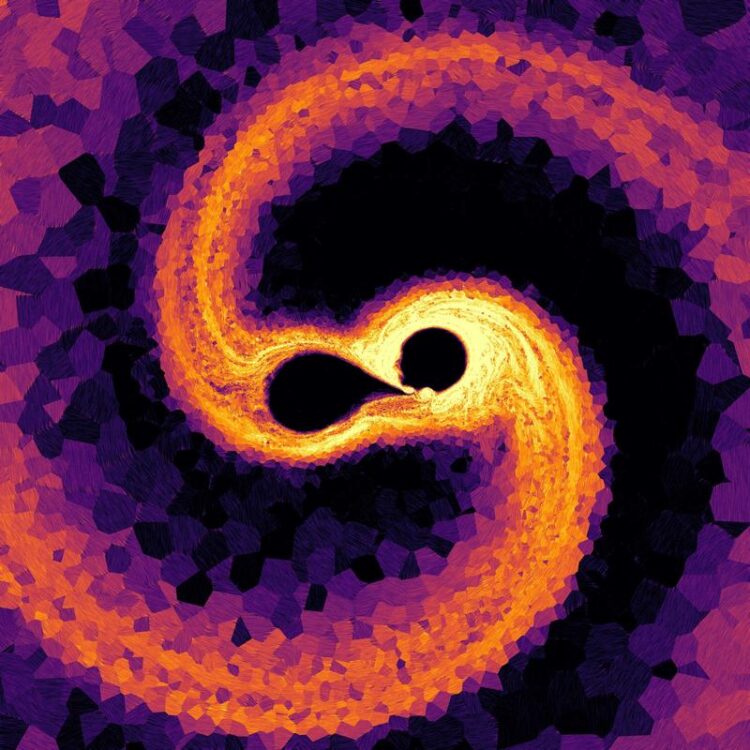Exploring the evolution of stars

The Simulation shown here marks the birth of the magnetic star Tau Scorpii, a so-called blue straggler that evolved from a binary merger.
Picture: Ohlmann/Schneider/Röpke
Fabian Schneider leads the new research group “Stellar Evolution Theory” (SET) at the Heidelberg Institute for Theoretical Studies (HITS). The astrophysicist explores the turbulent life of massive binary stars and their explosive deaths in supernovae. He was awarded an ERC Starting Grant of about € 1.5 million by the European Research Council (ERC). He will use the funds to establish his own junior research group at HITS.
Stars are the basic building blocks of the visible Universe. Astrophysicists are particularly interested in massive stars. They are cosmic powerhouses, exploding in spectacular supernovae and leaving behind some of the most exotic forms of matter: neutron stars and black holes. Mergers of neutron stars and black holes are now routinely observed thanks to gravitational wave observatories. But there are still a lot of questions that remain unanswered. Astrophysicist Fabian Schneider investigates the turbulent lives of massive stars. Since 1 January 2021, he has been leader of the new research group “Stellar Evolution Theory” at the Heidelberg Institute for Theoretical Studies (HITS). He had successfully applied for an ERC Starting Grant from the European Research Council (ERC), and he is now establishing his own junior research group. HITS now consists of 13 research groups, four of them in the field of astronomy.
Bonn – Oxford – Heidelberg: a scientific journey
Fabian Schneider studied physics at the University of Bonn and completed his Ph.D. in astrophysics at the Argelander-Institute for Astronomy in 2015. He then joined the Department of Physics of the University of Oxford as a “Hintze Fellow”, where he did research on massive stars, their magnetic fields and supernovae. During this time, he started to collaborate with Friedrich Röpke from HITS, a joint venture that became even more intensive after he moved to Heidelberg in 2018. Since then, Schneider has been a “Gliese Fellow” at the Center for Astronomy of Heidelberg University and, at the same time, visiting scientist in the PSO group at HITS. In October 2019, he published a study in “Nature” on the origin of magnetic fields in stellar mergers, together with colleagues from Garching and Oxford. In 2020, he was awarded an ERC Starting Grant and decided to choose HITS as the host institution for his new group.
When massive stars collide
The new SET group focuses on massive binary stars, which make up the majority of massive stars. During their lifetime, they can reach a stage where their outer layers are transferred onto their companion. The mass transfer profoundly changes the evolution of both stars. For example, if a star loses its envelope in a mass-transfer phase, it may explode in a supernova and produce a neutron star rather than collapsing into a black hole at the end of its life. In about 25% of massive stars, this mass-transfer even leads to a merger of both binary components.
Media Contact:
Dr. Peter Saueressig
Head of Communications
Heidelberg Institute for Theoretical Studies (HITS)
Phone: +49-6221-533-245
peter.saueressig@h-its.org
http://www.h-its.org/
Wissenschaftliche Ansprechpartner:
Scientific contact:
Dr. Fabian Schneider
Stellar Evolution Theory group (SET)
Heidelberg Institute for Theoretical Studies (HITS)
Phone: +49-6221-533 388
fabian.schneider@h-its.org
www.h-its.org
Weitere Informationen:
https://www.h-its.org/2021/01/18/evolution-of-stars/ HITS press release
Media Contact
All latest news from the category: Physics and Astronomy
This area deals with the fundamental laws and building blocks of nature and how they interact, the properties and the behavior of matter, and research into space and time and their structures.
innovations-report provides in-depth reports and articles on subjects such as astrophysics, laser technologies, nuclear, quantum, particle and solid-state physics, nanotechnologies, planetary research and findings (Mars, Venus) and developments related to the Hubble Telescope.
Newest articles

Innovative 3D printed scaffolds offer new hope for bone healing
Researchers at the Institute for Bioengineering of Catalonia have developed novel 3D printed PLA-CaP scaffolds that promote blood vessel formation, ensuring better healing and regeneration of bone tissue. Bone is…

The surprising role of gut infection in Alzheimer’s disease
ASU- and Banner Alzheimer’s Institute-led study implicates link between a common virus and the disease, which travels from the gut to the brain and may be a target for antiviral…

Molecular gardening: New enzymes discovered for protein modification pruning
How deubiquitinases USP53 and USP54 cleave long polyubiquitin chains and how the former is linked to liver disease in children. Deubiquitinases (DUBs) are enzymes used by cells to trim protein…


